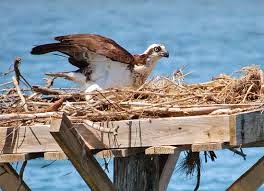Sunday 12th April 2015
Dutch Gap on the James River, Richmond VA
Richmond Audubon Society Outing
Adam's wife, Jean, joined Sue and I for this outing with the local bird group - the Richmond Audubon Society - on their outing to the James River at Dutch Gap. From the site map below you can see why this is such a good birding habitat.
 |
Dutch Gap Site Map
Library Picture |
Altogether there were 9 of us, including leader Lewis Barnett. The target bird for the group was the Prothonotary Warbler but Sue and I, being from UK, put the Bald Eagle at the top of the wish list. Thankfully both species were present.
- Quite early on we saw a juvenile Bald Eagle perched at the top of a dead tree some 200 metres away but showing well.
 |
Juvenile Bald Eagle
Library picture |
- Later on we had a superb view of an adult Bald Eagle flying overhead.
 |
Bald Eagle
Library picture |
- The local university has been running a programme for over 20 years aimed at encouraging the Prothonotary Warblers to breed here. They have provided numerous nest boxes like the one shown below as part of the process.
http://www.richmondaudubon.org/NewsProthonotary.html
 |
Prothonotary Warbler nest box
Library picture |
On the evidence of last year's visit and this year's experience, the scheme seems to be working very well with several birds seen without too much difficulty.
The birds themselves, of course, are quite stunning with their bright yellow plumage very prominent.
 |
Prothonotary Warbler
Library picture |
- The other bird species that caught our attention was the Red-winged Blackbird. Although a very common bird in these parts of the USA, we found the male to be stunning and so attractive with it's bright red epaulets and yellow margin.
 |
Red-winged Blackbird male
Library picture |
 |
Red-winged Blackbird male
Library picture |
By contrast, the female is totally without any red and almost starling-like in plumage.
 |
Red-winged Blackbird female
Library picture |
- There were plenty of Ospreys around and we were lucky on 2 occasions to see one catch a huge fish before flying off, presumably to the nest.
 |
Osprey with large fish
Library picture |
Shown below are pictures of some of the other birds we saw on our tour, in no particular order:
 |
Mourning Dove
Library picture |
 |
Wood Ducks flying
Library picture |
We only saw these lovely ducks in flight; I would dearly love to have seen them on the water so we could have had views like the one shown below
 |
Wood Duck
Library picture |
 |
Northern Flicker
Library picture |
This was our fourth different woodpecker species so far on this holiday.
 |
Blue-gray Gnatcatcher
Library picture |
 |
Pied-billed Grebe
Library picture |
 |
Ruby-crowned Ringlet
Library picture |
Very similar to our Goldcrest in size and colour.
 |
Eastern Phoebe
Library picture |
 |
Dark-eyed Junco
Library picture |
 |
Tree Swallow flying
Library picture |
 |
Tree Swallows perched
Library picture |
 |
Brown Thrasher
Library picture |
 |
Palm Warbler
Library picture |
 |
Pine Warbler
Library picture |
 |
Yellow-rumped Warbler
Library picture |
 |
Carolina Wren
Library picture |
Other species seen included the following:
(No pictures are shown either because they appear in earlier posts for this trip or they are common in UK)
Downy Woodpecker
European Starling
Black Vultures 20+
Turkey Vultures 20+
White-throated Sparrow
Song Sparrow
American Robin
Northern Mockingbird
Merlin
Great Blue Heron
Laughing Gull
Canada Goose
American Goldfinch
Brown-headed Cowbird
Double-crested Cormorant
American Coot
Carolina Chickadee
Northern Cardinal
Eastern Bluebird
A couple of teasers to finish with:
 |
Cormorant?
Library picture |
Of course it is but it's different to the UK one in that in that breeding adults show two tufted plumes on head.
 |
Double-crested Cormorant
Library picture |
Unfortunately we only saw the first image. Nevertheless a new species for me.
 |
| Crow ? |
It's another new species - a Fish Crow - nigh on identical to the American Crow and also to our UK Crow. The only real way to distinguish it from the other types is to hear it's call
Fish Crows have a distinctive caw that is short, nasal and quite different-sounding from an American Crow.
- This was the major birding trip of our holiday and it certainly lived up to expectations with lots of birds around including some "stonkers".
- As last year we were well looked after by our hosts and made to feel very welcome.
- Thanks to Lewis and also Gail/Mario who took over for the final part of the proceedings.


























































